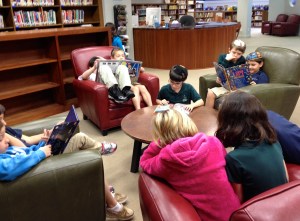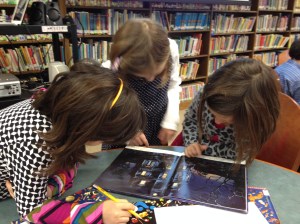Teacher Learning: 2nd Graders LOVE I SPY Books
It all began one Friday morning when I found my 2nd grade students sitting comfortably together in the library looking at I SPY and Where’s Waldo books. I thought: I must do something with those kids and those books! Turns out that Jean Marzollo, author of the I SPY series has a fantastic website. There she posted this challenge: A free 15- to 30-minute Skype visit with any class that creates “their own original beautiful I SPY pictures and write their own fantastic I SPY riddles.” I presented the idea to the kids and they were ready to take on this challenge!
Student Learning: Media Literacy
We spent our first lesson looking more closely at a number of different I SPY books, paying special attention to the image collages (choice of items displayed, arrangement of items, photographer perspective) and noting the beat and rhyme of the riddles.
To help students begin thinking about their individual pages for our class I SPY book, I created an organizer. It outlines the steps to create a page in the book as well as provides a space for writing the riddle. I wanted them to just brainstorm some ideas. Several kids knew exactly what items they wanted in their collages and drafted their ideas on the back of the paper. Other kids already practiced writing riddles.
Student Learning: Visual Literacy
Our next lessons were all about creating the image collages. We began by talking about what to look for when creating a collage using some examples I had prepared: not crowding the picture to make sure we can identify all items, taking the photo from a bird’s eye view, leaving a two-finger-spaces border, making sure to take a straight not crooked picture. Students used poster board as background. They were free to choose any items they found in the library for their collages. However, the big hit were the two bins of toys our 2nd grade teaching assistant, DeeAnn Wulbern, supplied on loan from her two sons.
Student Learning: Problem Solving
Some students worked in pairs, others preferred to create a collage on their own. We actually had two “gos” at this: our first attempt taught us that the white poster board worked better as background than any of the other colors. Also, its larger size provided more space for more creative creations. While I had mentioned to students that they should think of the riddles while creating their collages, none really did and were stuck when DeeAnn and I asked which items in their collages rhymed.
Finally, when the students returned the following week, we emphasized that in each collage there needed to be at least two rhyming items. Several students quickly figured out how to best approach this issue by first finding the “just right” item and then searching for something else that rhymes with it. Only then do you look for other things to add to the collage. Watch our student Talia explain the process of creating an image collage.
Once the collages were created, students took pictures using the iPad. It was not always easy holding the iPad perfectly straight and still, or even be up high enough to get the full bird’s eye view. Multiple pictures were taken and the best selected.
Student Learning: Rhythm and Rhyme
I SPY riddles are written in a 4-beats per line rhythm and an aabb rhyme format. Our students wrote 2-line riddles. To better grasp the rhythm, we listened to some examples of student-created I SPY raps on Jean Marzollo’s website. We also clapped with the beat using some example riddles. If you’d like more information on her riddles, see Jean Marzollo’s brief video on “How to Write an I Spy Riddle”. The students then got to work using the following template:
Student Learning: Digital Literacy
Each student created an I SPY page using the BookCreator app for iPad. They imported their images into the app and then typed their riddles, choosing legible fonts and using the dictionaries to ensure correct grammar and spelling–because, remember, Jean Marzollo is looking for quality work!
Teacher Learning: A Project Worth Repeating
The students and their teachers LOVED this hands-on project. It highlights the four Cs of modern learning: critical thinking, communication, collaboration, and creation. But best of all, it is an extremely engaging project. Now we are ready to visit with Jean Marzollo via Skype for her feedback on our great product. Take a look!
Download on the iBooks store:













Pingback: Passover Haiku Poetry | Liquid Literacy